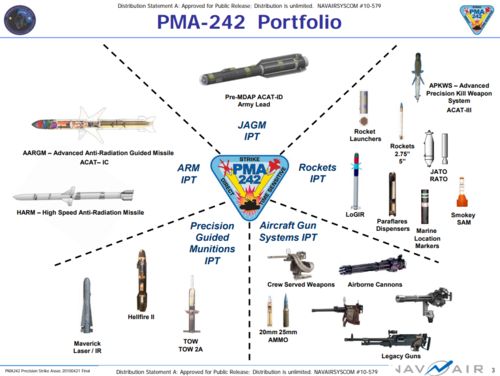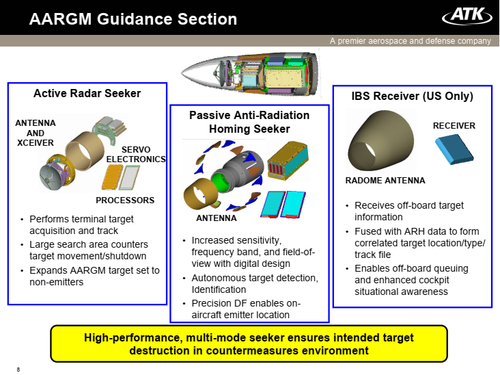Colleagues, can you list anti-radiation missiles (ARMs) by nomenclature and possibly with basic specs, both historic and contemporary, which can lock on and knock out Soviet/Russian/CIS VHF radars like the P-18 (Spoon Rest), P-14 / 5N84A Oborona (Tall King), Nebo M / SV / SVU (Box Spring), Vostok E, Rezonans N / NE, etc? Are there any?
You are using an out of date browser. It may not display this or other websites correctly.
You should upgrade or use an alternative browser.
You should upgrade or use an alternative browser.
Anti-radiation missiles which can lock on VHF radars
- Thread starter yahya
- Start date
I don't know of any. HARM C model allegedly went to 0.5 GHz as the lowest band, that'd still be UHF band. In all likelihood during the cold war there was no such capability, to home in on VHF radars. Of course today that might be different, but it's unlikely there will be public data available on modern day ARMissiles.
Thank you, totoro. Right, VHF top end is 0.3 GHz. I am not sure how a VHF seeker of such ARMs might look like, but we have to consider that VHF antennas are de facto larger than for the UHF and SHF bands. Accommodating a working directional one into a 10" HARM's diameter might still be a technical challenge.
- Joined
- 18 May 2019
- Messages
- 636
- Reaction score
- 1,570
Thank you, totoro. Right, VHF top end is 0.3 GHz. I am not sure how a VHF seeker of such ARMs might look like, but we have to consider that VHF antennas are de facto larger than for the UHF and SHF bands. Accommodating a working directional one into a 10" HARM's diameter might still be a technical challenge.
Conformal antennas are being studied for this application
are they in the production? most likely not
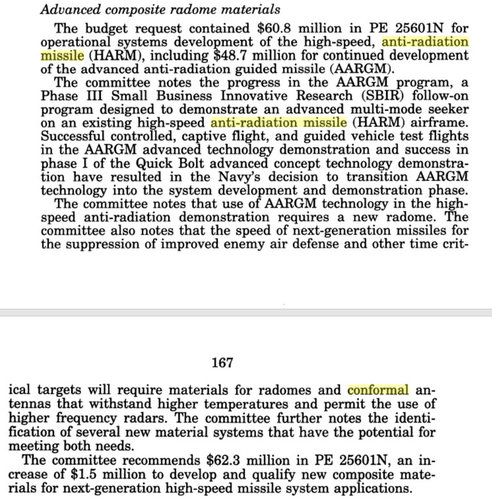
Last edited:
- Joined
- 11 February 2010
- Messages
- 1,451
- Reaction score
- 1,955
Currently there are no anti radiation missile in design capable of home in to a VHF band radar. Seekers of current ARM's are just not having the frequency coverage to VHF, They're just way too small.
Conformal antenna are just to ensure wide coverage OR allow another seeker to be placed in, it does not offer any advantage on frequency coverage.
There is however a patent related to a methods of improving frequency coverage
But to my knowldege, so far it has not been used in any missiles.
Conformal antenna are just to ensure wide coverage OR allow another seeker to be placed in, it does not offer any advantage on frequency coverage.
There is however a patent related to a methods of improving frequency coverage
But to my knowldege, so far it has not been used in any missiles.
- Joined
- 16 April 2008
- Messages
- 8,397
- Reaction score
- 10,351
ARMs are generally used against targeting and fire control sets, not early warning systems. The range on VHF sets against normal aircraft is such that the radar would have detected inbound strike aircraft (or Weasels) long before the ARM comes into range. (For Stealth aircraft, very different issues at work.) At that point, assuming you can defeat the actual fire control sets around the VHF radar, the best way to kill the VHF set itself would probably be a bunch of cluster bombs across the antenna or a blast frag warhead through the control cab (which might be part of why cluster bombs and Maverick were part of Wild Weasel weapon loads). And of course now, as long as you can geolocate the emitter, you don't necessarily need an ARM to kill it.
The more likely counter to VHF-band early warning radars would be stand-off jammers, since they can generally work from outside the range of defensive SAM belts.
The more likely counter to VHF-band early warning radars would be stand-off jammers, since they can generally work from outside the range of defensive SAM belts.
- Joined
- 11 February 2010
- Messages
- 1,451
- Reaction score
- 1,955
One example is.. let's take a hypothetical ARM with conical spiral antenna design (e.g Kh-31). We desire lower frequency coverage of 140 MHz.
The lower frequency coverage is determined by the base diameter of the antenna, and can be estimated with following
B=3c/(8Flw)
Where B is base in meter
C is lightspeed
Flw is the lower frequency coverage desired in Hz.
Using Typical VHF Frequency of 140 MHz and 175 MHz, it would need base diameter of about 0.6-0.8 m. Clearly this wont fit in any tactical missile, let alone making an array of it for any form of direction finding.
The lower frequency coverage is determined by the base diameter of the antenna, and can be estimated with following
B=3c/(8Flw)
Where B is base in meter
C is lightspeed
Flw is the lower frequency coverage desired in Hz.
Using Typical VHF Frequency of 140 MHz and 175 MHz, it would need base diameter of about 0.6-0.8 m. Clearly this wont fit in any tactical missile, let alone making an array of it for any form of direction finding.
VHF radars aren't typically very mobile, and least older models. The most modern Russian and Chinese models are, but still have to have large power supply and atenna. It probably is worth using EW aircraft to locate such a target and then a GPS PGM to eliminate rather than dedicate an arm to low freq work. Also the newest ARMs use GPS and terminal guidance - I suspect AGM-88E can be given the proper coordinates of such a target and work effectively.
How about a linear array? like one on wing edge of F-35 and wing tip of EA-18GOne example is.. let's take a hypothetical ARM with conical spiral antenna design (e.g Kh-31). We desire lower frequency coverage of 140 MHz.
The lower frequency coverage is determined by the base diameter of the antenna, and can be estimated with following
B=3c/(8Flw)
Where B is base in meter
C is lightspeed
Flw is the lower frequency coverage desired in Hz.
Using Typical VHF Frequency of 140 MHz and 175 MHz, it would need base diameter of about 0.6-0.8 m. Clearly this wont fit in any tactical missile, let alone making an array of it for any form of direction finding.
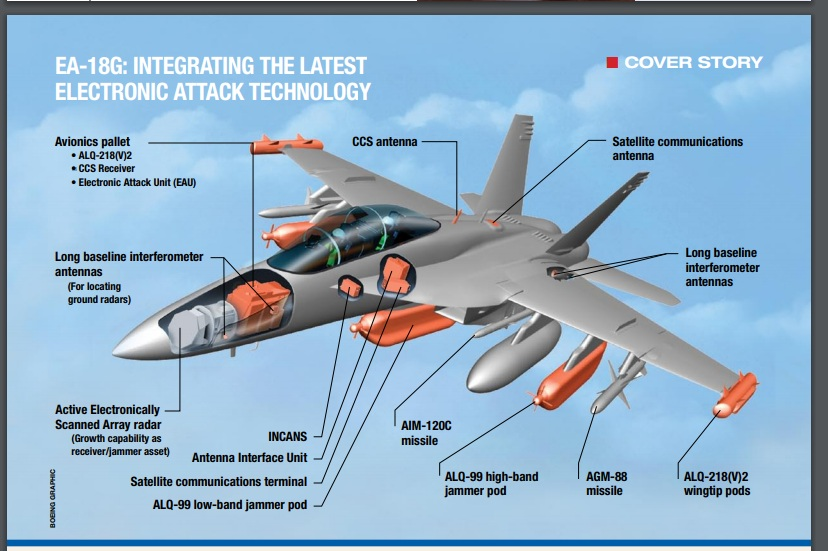
- Joined
- 11 February 2010
- Messages
- 1,451
- Reaction score
- 1,955
How about a linear array? like one on wing edge of F-35 and wing tip of EA-18G
So you want to make a "Span loader" missile ?
The issue here is related to how big the antenna is to get the adequate frequency coverage. The array system adds precision where you geolocate the target.
Im thinking that you can have linear antenna along missile body, then with datalink, 2 missiles can talk to each other to geolocate target.So you want to make a "Span loader" missile ?
The issue here is related to how big the antenna is to get the adequate frequency coverage. The array system adds precision where you geolocate the target.
I found something:Colleagues, can you list anti-radiation missiles (ARMs) by nomenclature and possibly with basic specs, both historic and contemporary, which can lock on and knock out Soviet/Russian/CIS VHF radars like the P-18 (Spoon Rest), P-14 / 5N84A Oborona (Tall King), Nebo M / SV / SVU (Box Spring), Vostok E, Rezonans N / NE, etc? Are there any?
TECHNOLOGY AREAS: Sensors, Electronics, Battlespace, Weapons
ACQUISITION PROGRAM: PMA-242 Direct and Time Sensitive Strike Weapon Program

The technology within this topic is restricted under the International Traffic in Arms Regulation (ITAR), which controls the export and import of defense-related material and services. Offerors must disclose any proposed use of foreign nationals, their country of origin, and what tasks each would accomplish in the statement of work in accordance with section 3.5.b.(7) of the solicitation.
OBJECTIVE: Develop and demonstrate conformal antennas suitable for a number of existing missile airframes which are capable of transmitting and receiving an ultra wide bandwidth of frequencies.
DESCRIPTION: Innovative conformal antenna designs are being sought which are capable of operating in two specific bands of interest. The lower band covers the frequencies of 30 Mega Hertz (MHz) to 1000 MHz (the first Radio Frequency (RF) port) and the other band covers 960 MHz to 2000 MHz (the second RF port).
Current weapon antennas are confined to narrow bands and are directional. Software Defined Radios (SDR) are becoming the choice for data terminals for weapons. SDRs avoid costs associated with hardware changes for weapons that are in storage for up to 20 years. To allow the upgrades to SDRs, comparable antennas are needed to allow new spectrum utilization. Also, the Network Enabled Weapons (NEW) need to operate in an omni-directional environment to allow simultaneous link completion with as many network nodes as is possible.
Conformal antennas are needed to mount on existing missile bodies. The introduction of new antennas cannot produce new aero structures as that would force redesign of propulsion systems, force redesign of control surfaces, and force expensive recertification of the airframe. These antennas will be installed on existing airframes. The fundamental designs will need to scale to be accommodated on multiple missile airframes. The following are design goals for the conformal antennas:
Size - Conformal, with depths less than 0.7 inch. The anticipated missile diameters will range from a minimum of 9 inches to a maximum of 21 inches.
Weight - These antennas will need to be retrofitted on existing airframes. The combined weight of the antennas cannot exceed 5 lbs.
Bandwidth - Two bands are of interest. The lower band covers 100 MHz to 1000MHz and the other covers 960 MHz to 2000 MHz. The Voltage Standing Wave Ratio (VSWR) needs to be equal to or less than 2:1.
Antenna Pattern - Threshold: Less than 2 decibel isotropic (dBi) variance Goal: Omni over the entire bandwidth. Antenna gains for legacy waveforms will need to be the same or better than existing antennas. Polarization - Vertical relative to skin of weapon airframe.
Materials - Temperatures need to withstand high speed (supersonic) flight and need to be highly repeatable for manufacturing purposes.
Power - This is a transceiver and both antennas will need to handle a nominal power of 90 Watts with a maximum of 125 Watts.
Structural - The installation of the antennas cannot degrade the structural integrity of the weapon all up round. Ideally, it would not be a stressed airframe component. Analysis will need to be done to show that it will not degrade structural integrity.
PHASE I: Demonstrate proof of concept antenna design using modeling and simulation to characterize the performance of the antenna relative to the design goals listed above.
PHASE II: Based on the results from Phase I, design a prototype conformal antenna and demonstrate its performance in a laboratory environment.
PHASE III: Develop an engineering model of the antenna and integrate with a notional missile. The goal is the Advanced Anti Radiation Guided Missile (AARGM) and flight test with Office of Naval Research (ONR) Weapons Data Link (WDL) terminal.
So I think AARGM-ER and SIAW can have the ability to home on VHF radar.
Last edited:
- Joined
- 11 February 2010
- Messages
- 1,451
- Reaction score
- 1,955
Im thinking that you can have linear antenna along missile body, then with datalink, 2 missiles can talk to each other to geolocate target.
Then you are looking for a new missile as the datalink element will add weight and power requirement. and you have to expend 2 missiles per target.
Ideally you would want 1 missile/ target as radar is a soft target.
So I think AARGM-ER and SIAW can have the ability to home on VHF radar.
Yeah when such antenna are succesfully developed and actually being deployed. Patent for such antenna are around as i showed above but No missiles are being made out of it.
From many means to home in and kill on VHF band Radar is unfortunately may not include ARM's.
AARGM and AARGM-ER, SIAW all have 2 way data linkThen you are looking for a new missile as the datalink element will add weight and power requirement. and you have to expend 2 missiles per target.
Ideally you would want 1 missile/ target as radar is a soft target.
I read something about AARGM uses a conformal antenna to have space for its terminal MMW seeker, could the system is already implemented?Yeah when such antenna are succesfully developed and actually being deployed. Patent for such antenna are around as i showed above but No missiles are being made out of it.
From many means to home in and kill on VHF band Radar is unfortunately may not include ARM's.
The AARGM upgrade currently in development for the HARM addresses these weaknesses and introduces many additional capabilities transforming the missile into a modern network-enabled weapon. Primarily, the analog RF seeker is replaced by a digital receiver, providing advanced features such as autonomous detection (not dependent on aircraft radar warning receivers) and target recognition (Target ID). The new seeker supports a conformal antenna, clearing the nose cone for a Millimeter Wave (MMW) seeker. With the two seekers AARGM supports ‘blended strike solutions’, implementing INS/GPS for midcourse navigation and active or passive RF techniques for the terminal phase (active MMW or passive RF seeker).
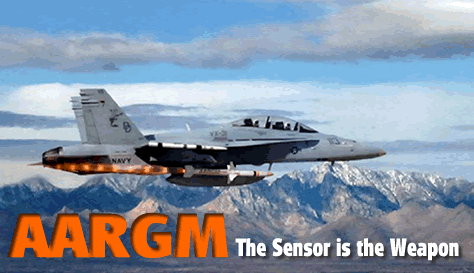
AGM-88E AARGM – The Sensor is the Weapon - Defense Update:
An example of a specialized weapon expanding its capabilities to match new and illusive target is the AGM-88 High Speed Anti-Radiation (HARM) missile
- Joined
- 11 February 2010
- Messages
- 1,451
- Reaction score
- 1,955
[
AARGM and AARGM-ER, SIAW all have 2 way data link
For missile to aircraft not for missile to missile. For that purpose you may need additional antenna as the missile may not necessarily able to keep "in pair" with each other.
I read something about AARGM uses a conformal antenna to have space for its terminal MMW seeker, could the system is already implemented?
The AARGM upgrade currently in development for the HARM addresses these weaknesses and introduces many additional capabilities transforming the missile into a modern network-enabled weapon. Primarily, the analog RF seeker is replaced by a digital receiver, providing advanced features such as autonomous detection (not dependent on aircraft radar warning receivers) and target recognition (Target ID). The new seeker supports a conformal antenna, clearing the nose cone for a Millimeter Wave (MMW) seeker. With the two seekers AARGM supports ‘blended strike solutions’, implementing INS/GPS for midcourse navigation and active or passive RF techniques for the terminal phase (active MMW or passive RF seeker).
AGM-88E AARGM – The Sensor is the Weapon - Defense Update:
An example of a specialized weapon expanding its capabilities to match new and illusive target is the AGM-88 High Speed Anti-Radiation (HARM) missiledefense-update.com
Yeah and that conformal antenna covers the previously existing band which is not including VHF, Originally the HARM seeker was conical antenna which occupy the whole seeker radome. Took that away replace the conical seeker with MMW. and to remain as an ARM with pre-existing band then conformal solution have to be sought.
Oh and source of the image :
Attachments
Last edited:
Not an anti radiation missile exactly, but there is some possibility that SPEAR-EW can track VHF radar, since low frequency antenna will be intergrated into its wing and it will be used in ISTAR role as wellColleagues, can you list anti-radiation missiles (ARMs) by nomenclature and possibly with basic specs, both historic and contemporary, which can lock on and knock out Soviet/Russian/CIS VHF radars like the P-18 (Spoon Rest), P-14 / 5N84A Oborona (Tall King), Nebo M / SV / SVU (Box Spring), Vostok E, Rezonans N / NE, etc? Are there any?
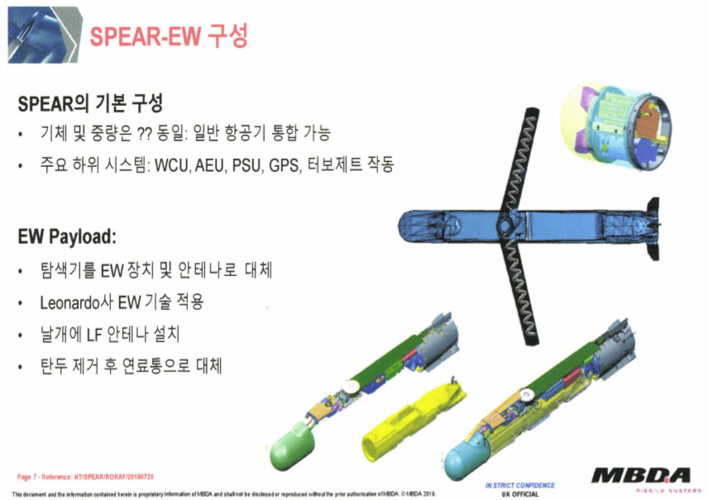
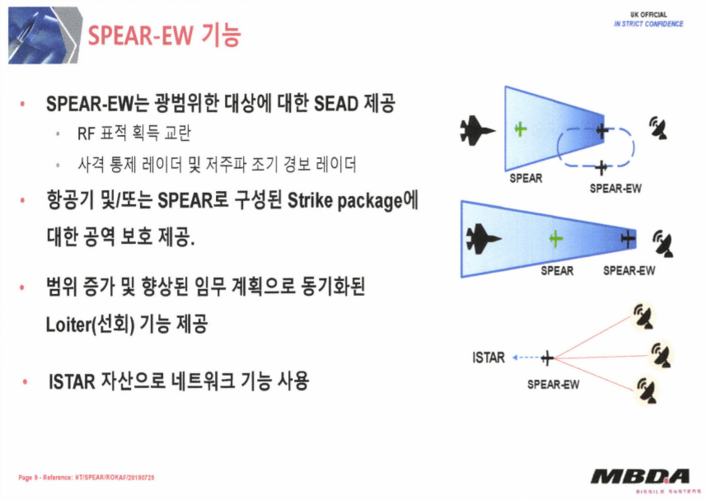
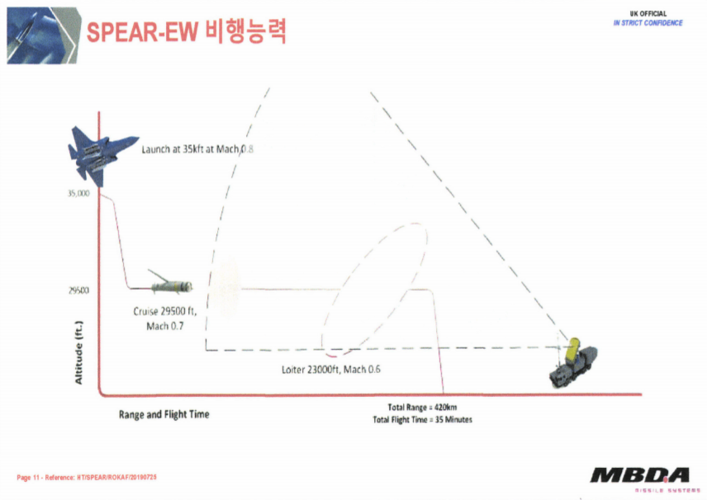
A possible option, the USN Next Generation Jammer - Low Band, NGJ-LB, program for the EA-18G entered EMD phase end of 2020, could the pod less the jammer be used to supply targeting info to the Army Precision Strike Missile via the envisaged new meta network for Combatant Commanders, the Joint All Domain Command and Control, JADC2.
Similar threads
-
Which airborne jammers can jam VHF radars?
- Started by yahya
- Replies: 2

